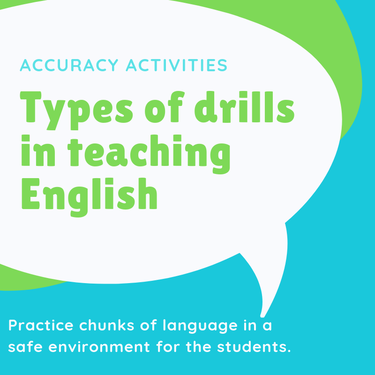Drilling is a lingual technique to introduce new language items to your students based on students repeating a model provided by the teacher. It used after teaching new vocabulary, grammar points and sentence structures. Drills are usually conducted chorally (the whole class repeats) then individually.
This technique is used to:
- Focus on accuracy rather than fluency.
- Improve students´ pronunciation.
- Provide practice on difficult sounds and imitate intonation.
- Practice chunks of the language in a safe environment for the students.
- Memorize common language patterns.
There are different types of drills:
1. The repetition drill
The teacher says models (the word or phrases) and the students repeat it to acquire acceptable pronunciation using the proper stress, rhythm and intonation where required.
Example #1:
Teacher : I like cooking.
Students : I like cooking.
Teacher : I like playing.
Students : I like playing.
Verbs to express daily actions: cook, play, read, watch, ride, skate, go out, swim, listen, do, sing, talk, chat, text, etc.
Example #2:
Teacher : I dislike listening to rock music.
Students : I dislike listening to rock music.
Teacher : I hate doing homework.
Students : I hate doing homework.
Teacher : I enjoy going out.
Students : I enjoy going out.
Teacher : I love chatting.
Students : I love chatting.
Verbs to express likes and dislikes: like, dislike, hate, enjoy, love, adore, detest, loathe, etc.
2. The substitution drill
The teacher substitutes one or more keywords, or changes the prompt, and the learners say the new structure.
2.1 Simple substitution drill
The teacher reads a sentence and the students repeat it, and then calls out a word that the students must fit into the sentence.
Example:
Teacher : Diana likes pop music.
Students : Diana likes pop music.
Teacher : Rock.
Students : Diana likes rock music.
Teacher : He hates doing homework.
Students : He hates doing homework.
Teacher : Karate.
Students : He hates doing karate.
Teacher : I like watching TV.
Students : I like watching TV.
Teacher : He.
Students : He likes watching TV.
Teacher : They like going out.
Students : They like going out.
Teacher : (not)
Students : They don’t like going out.
2.2 Multiple substitution drill
The teacher reads a sentence and the students repeat it, and then calls out two or more words that the students must fit into the sentence.
Example:
Teacher : My brother likes listening to pop music.
Students : My brother likes listening to pop music.
Teacher : sister - rock.
Students : My sister likes listening to rock music.
Teacher : mother – romantic.
Students : My mother likes listening to romantic music.
3. Question and answer drill
The teacher gives students practice with answering questions. The students should answer the teacher’s questions very quickly. It is also possible for the teacher to let the students practice asking a question as well. This gives students practice with the question pattern.
Example:
Teacher : Does he like pizza? Yes?
Students : Yes, he does.
Teacher : No?
Students : No, he does not.
4. Transformation drill
The teacher gives students a certain kind of sentence pattern, an affirmation sentence for example. Students are asked to transform this sentence into a negative sentence. Other examples of transformations to ask of students are changing a statement into a question, an active sentence into a passive one, or direct speech into a reported speech.
Example: (positive into negative)
Teacher : I clean the house.
Students : I don’t clean the house.
Teacher : She sings a song.
Students : She doesn’t sing a song.
Teacher : My favorite hobby is playing chess.
Students : My favorite hobby is not playing chess.
5. Replacement drill
Students replace a noun with a pronoun. It is the same drill as substitution drill but it involves with a replacement.
Example:
Teacher : I like yoga.
Students : I like it.
Teacher : Baseball and volleyball are my favorite sports.
Students : They are my favorite sports.
Teacher : Michael doesn’t like comics.
Students : He doesn’t like comics.
6. The expansion drill
This drill is used when a long line dialog is giving students trouble. The teacher breaks down the line into several parts. The students repeat a part of the sentence, usually the last phrase of the line. Then following the teacher’s cue, the students expand what they are repeating part at the end of the sentence (and works backward from there) to keep the intonation of the line as natural as possible. This also directs more student attention to the end of the sentence, where new information typically occurs.
Example:
Teacher : My sister is 9 years old.
Students : My sister is 9 years old.
Teacher : She likes playing soccer.
Students : She likes playing soccer.
Teacher : My sister is 9 years old. She likes playing soccer.
Students : My sister is 9 years old. She likes playing soccer.
Teacher : She is a goalkeeper.
Students : She is a goalkeeper.
Teacher : My sister is 9 years old. She likes playing soccer. She is a goalkeeper.
Students : My sister is 9 years old. She likes playing soccer. She is a goalkeeper.


